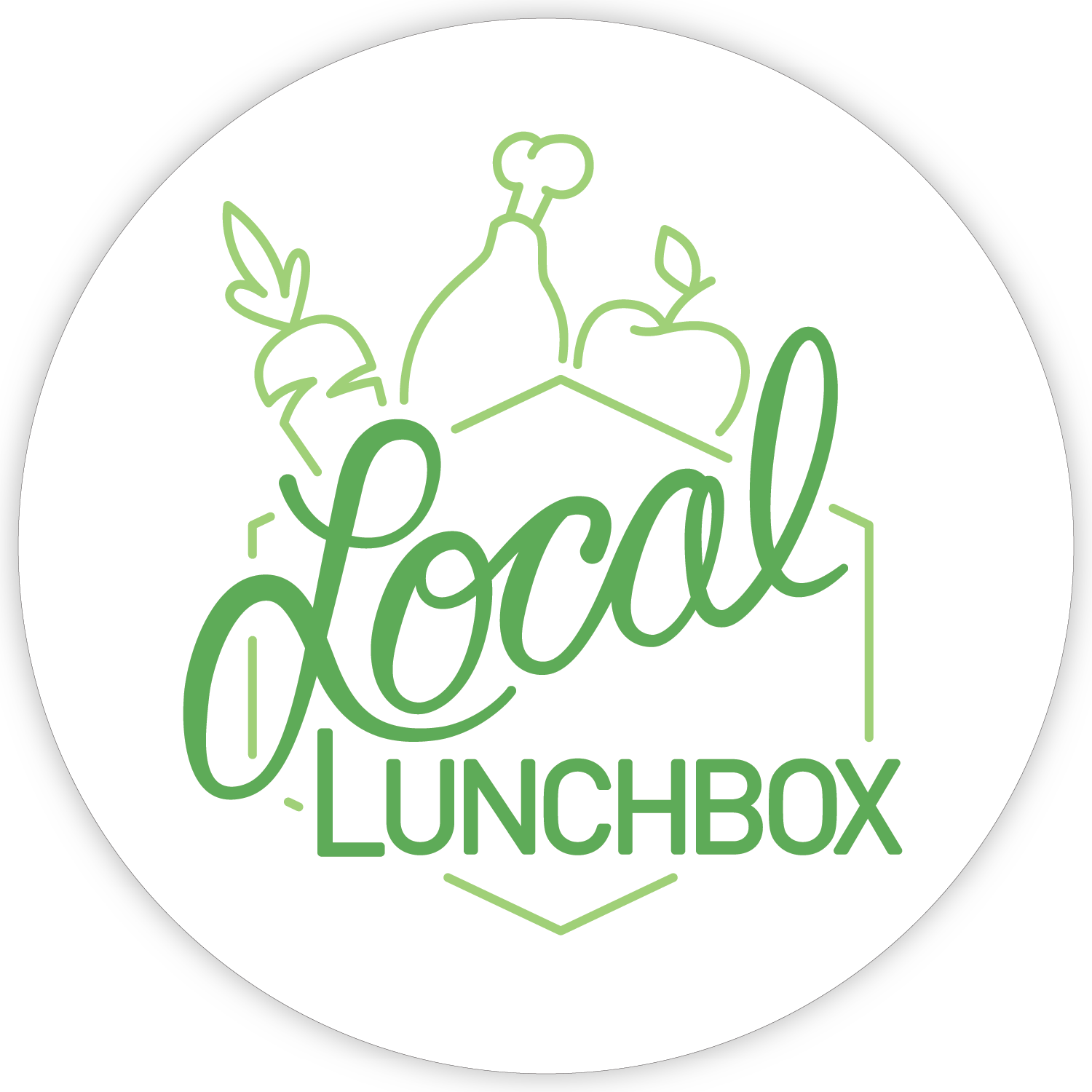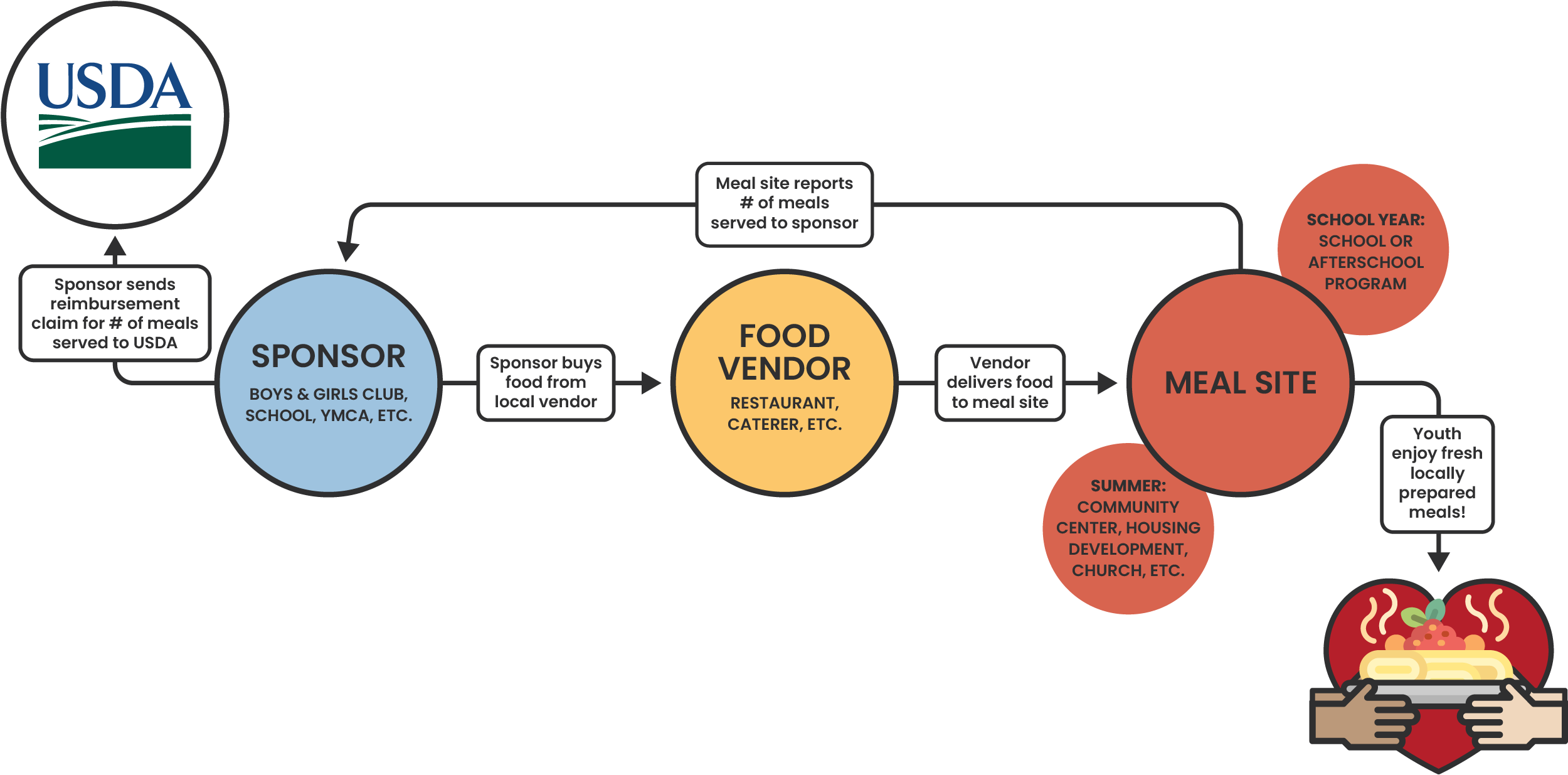About USDA Child Nutrition Programs
The USDA provides over $25 billion in funding each year to support child nutrition programs nationwide. These programs provide year-round access to meals for low income kids and teens. All USDA child nutrition programs work the same way:
A financial sponsor purchases food from a food vendor
The food vendor delivers food to the meal site
The meal site serves the food to kids
The financial sponsor reports the number of meals served to the state education board
The state education board processes the reimbursement with the USDA and pays the financial sponsor for meals served.
HOW IT WORKS:
The NSLP is the USDA’s largest child nutrition program. It provides lunch for 30 million students nationwide every year.
View the USDA website: www.fns.usda.gov/nslp
Operation guidelines
Only schools / school districts can be a Financial Sponsor
Meals must be served at school, during the school day
Operates during the school year
Covers lunch (with separate option for after-school snack)
Meal cost (free/reduced price/paid) for children is based on their income eligibility
Reimbursement rates
NSLP reimbursement rates are effective from July 1st through June 30th and are updated each year.
National School Lunch Program
| Districts where less than 60% of the lunches served in the second preceding school year were free/reduced | |||
|---|---|---|---|
| Contiguous States | Alaska | Guam, Hawaii, Puerto Rico, US Virgin Islands | |
| Paid | 0.42 | 0.64 | 0.48 |
| Reduced | 3.33 | 5.61 | 3.95 |
| Free | 3.73 | 6.01 | 4.35 |
| Districts where more than 60% of the lunches served in the second preceding school year were free/reduced | |||
|---|---|---|---|
| Contiguous States | Alaska | Guam, Hawaii, Puerto Rico, US Virgin Islands | |
| Paid | 0.44 | 0.66 | 0.50 |
| Reduced | 3.35 | 5.63 | 3.97 |
| Free | 3.75 | 6.03 | 4.37 |
| Maximum rate | |||
|---|---|---|---|
| Contiguous States | Alaska | Guam, Hawaii, Puerto Rico, US Virgin Islands | |
| Paid | 0.50 | 0.75 | 0.56 |
| Reduced | 3.59 | 5.86 | 4.14 |
| Free | 3.90 | 6.26 | 4.54 |
*Note: these rates include an additional $0.07 for performance-based cash assistance. Read more: 7 CFR Part 210
Read more:
Meal pattern
Interactive training from the TX Department of Agriculture: Meal Pattern Requirements for the National School Lunch Program
Offer vs. serve:
Offer versus Serve (OVS) allows students to decline some of the food offered. The goals of OVS are to reduce food waste in the school meals programs while permitting students to decline foods they do not intend to eat.
For lunch, schools must offer all five required food components in at least the minimum required amounts: meats/meat alternates; grains; fruit; vegetables; and fluid milk.
Students must take at least three components in the required serving sizes. One selection must be at least ½ cup from either the fruit or vegetable component.
The SBP provides breakfast for over 15 million kids at school, during the school year.
View the USDA website: School Breakfast Program
Operation guidelines
Only schools / school districts can be a Financial Sponsor
Meals must be served at school, during the school day
Operates during the school year
Covers breakfast
Meal cost (free/reduced price/paid) for children is based on their income eligibility
Reimbursement rates
SBP reimbursement rates are effective from July 1st through June 30th and are updated each year.
School Breakfast Program
| Non-Severe Need
Fewer than 40% of lunches served in the second preceding school year were free/reduced |
|||
|---|---|---|---|
| Contiguous States | Alaska | Guam, Hawaii, Puerto Rico, US Virgin Islands | |
| Paid | 0.33 | 0.50 | 0.38 |
| Reduced | 1.67 | 2.85 | 1.99 |
| Free | 1.97 | 3.15 | 2.29 |
| Severe Need
40% or more of lunches served in the second preceding school year were free/reduced |
|||
|---|---|---|---|
| Contiguous States | Alaska | Guam, Hawaii, Puerto Rico, US Virgin Islands | |
| Paid | 0.33 | 0.50 | 0.38 |
| Reduced | 2.05 | 3.48 | 2.44 |
| Free | 2.35 | 3.78 | 2.74 |
Read more:
Eligibility for Severe Need Rates for the School Breakfast Program
Federal Register/Vol. 86, No. 134/Friday, July 16, 2021/Notices
Meal patterns
School Breakfast Program Meal Pattern Chart
Interactive training from the TX Department of Agriculture: Meal Pattern Requirements in the School Breakfast Program
Offer vs. serve:
Offer versus Serve (OVS) allows students to decline some of the food offered. The goals of OVS are to reduce food waste in the school meals programs while permitting students to decline foods they do not intend to eat.
At breakfast, schools must offer students all three required food components: grains (with optional meats/meat alternates allowed); juice/fruit/vegetable; and milk.
Under OVS, a student must be offered at least four food items and must select at least three food items, one of which must be ½ cup of fruit or vegetables for OVS.
CACFP reimburses meals served to children and adults who enrolled for care at participating child care centers, day care homes, and adult day care centers. It also covers children and youth in afterschool programs, children residing in emergency shelters, and adults over the age of 60 or living with a disability and enrolled in day care facilities.
View the USDA website: www.fns.usda.gov/cacfp
Operation guidelines
CACFP is offered year-round, although many programs switch to SFSP during the summer
Child care centers: public or private nonprofit child care centers, outside-school-hours care centers, Head Start programs, and other institutions which are licensed or approved to provide day care services
Adult day care centers: public or private nonprofit adult day care (non-residential) facilities serve adults who are functionally impaired, or aged 60+
Covers snack and supper
Reimbursement rates
CACFP reimbursement rates are effective from July 1st through June 30th and are updated each year.
Child Care Centers and After-School Programming
Child and Adult Care Feeding Program
| Breakfast
| |||
|---|---|---|---|
| Contiguous States | Alaska | Hawaii | |
| Paid | 0.33 | 0.50 | 0.38 |
| Reduced | 1.67 | 2.85 | 1.99 |
| Free | 1.97 | 3.15 | 2.29 |
| Lunch/Supper
| |||
|---|---|---|---|
| Contiguous States | Alaska | Hawaii | |
| Paid | 0.35 | 0.57 | 0.41 |
| Reduced | 3.26 | 5.54 | 3.88 |
| Free | 3.66 | 5.94 | 4.28 |
| Supplement
| |||
|---|---|---|---|
| Contiguous States | Alaska | Hawaii | |
| Paid | 0.09 | 0.14 | 0.10 |
| Reduced | 0.50 | 0.81 | 0.58 |
| Free | 1.00 | 1.63 | 1.17 |
For adult day care facility reimbursement rates, read more here: CACFP Reimbursement Rates
Meal patterns
The Summer Food Service Program
The Summer Food Service Program (SFSP) provides kids and teens in low-income areas free meals when school is out
View the USDA website: www.fns.usda.gov/sfsp/summer-food-service-program
Eligible sponsors: schools/districts, local government, non profits, colleges/universities, community and faith-based organizations
Operates May - September, whenever school is out for the summer
Meals can be offered wherever is convenient for kids: schools, camps, churches, community centers, housing projects, libraries, migrant centers, laundromats, parks, playgrounds, pools, and other public sites where children gather
Child eligibility to participate is determined at the site level - see below for more info
How it works
There are three main players involved: State agencies, sponsors, and sites.
State agencies administer the program and communicate with USDA.
Sponsors enter into agreements with State agencies to run the program. Schools, local government agencies, camps, faith-based and other non-profit community organizations that have the ability to manage a food service program may be SFSP sponsors. Sponsors get reimbursed by the Program and may manage multiple sites.
Sites are places in the community where children receive meals in a safe and supervised environment. Sites may be located in a variety of settings, including schools, parks, community centers, health clinics, hospitals, apartment complexes, churches, and migrant centers. Sites work directly with sponsors.
Operation guidelines
Meals must be offered alongside some kind of programming
Meals must be eaten on site, in person
Sites can choose from breakfast, lunch, supper, and snack – you can choose up to 2 meals, but can’t choose lunch AND supper
Sites can be open (any child can attend) or closed (only kids on the roster can attend)
Reimbursement rates
| All states except Alaska and Hawaii
| ||
|---|---|---|
| Rural or Self-Prep | All other types of sites | |
| Breakfast | 2.6050 | 2.5550 |
| Lunch or Supper | 4.5625 | 4.4875 |
| Snack | 1.0775 | 1.0525 |
| Alaska
| ||
|---|---|---|
| Rural or Self-Prep | All other types of sites | |
| Breakfast | 4.2200 | 4.1400 |
| Lunch or Supper | 7.4000 | 7.2800 |
| Snack | 1.7500 | 1.7100 |
| Hawaii
| ||
|---|---|---|
| Rural or Self-Prep | All other types of sites | |
| Breakfast | 3.0450 | 2.9875 |
| Lunch or Supper | 5.3450 | 5.2600 |
| Snack | 1.2675 | 1.2375 |
Learn more
Creative examples of SFSP programs: Summer Food Service Program Best Practice Guide
Schools participating in the National School Lunch or School Breakfast Program are eligible to apply for the Seamless Summer Option (SSO). Compared with SFSP, SSO has less paperwork and auditing; however, meals are reimbursed at the free rates for school lunches, school breakfasts, and afterschool snacks, which are slightly lower than SFSP.
View the USDA website: www.fns.usda.gov/sfsp/seamless-summer-and-other-options-schools
Operation guidelines
SSO is offered during the summer only
Only schools / districts can sponsor SSO
Can reimburse for breakfast, lunch, snack
All meals are free for kids (Although camps are only reimbursed for children who qualify for free or reduced price meals, camp sponsors may, and usually do, provide meals free of charge to all children)
Meals can only be offered at schools or residential child-care institutions (vs. SFSP, which can offer meals basically anywhere)
Reimbursement rates
SSO reimbursement rates are effective from July 1st through June 30th and are updated each year.


